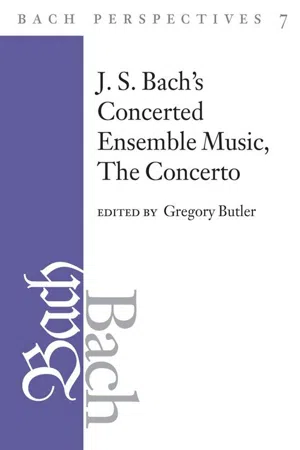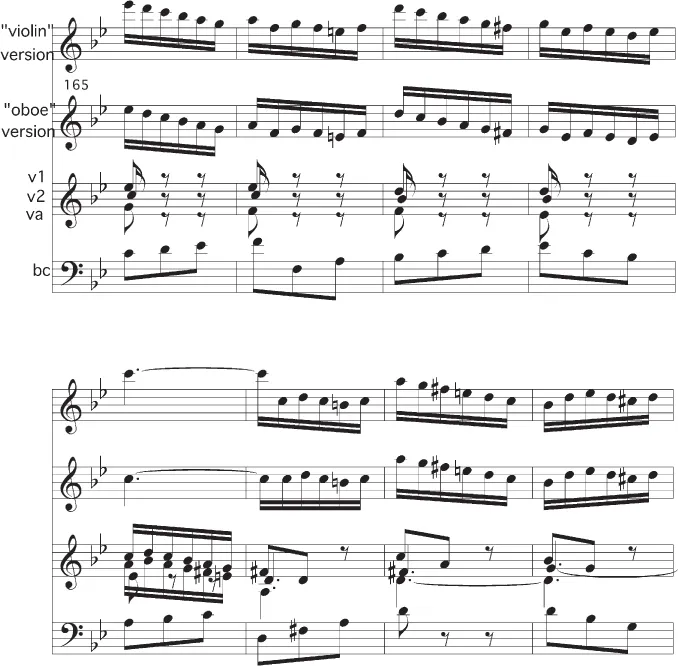![]()
J. S. Bach’s Violin Concerto in G Minor
Pieter Dirksen
Johann Sebastian Bach’s concertos for solo cembalo (BWV 1052–59), preserved together in the autograph score P 234 (ca. 1738), are, without exception, transcriptions of concertos for solo treble instruments. For seven of the concertos, the Urform has either been preserved—BWV 1054 (BWV 1042), BWV 1057 (BWV 1049), BWV 1058 (BWV 1041)—or the original solo instrument can be determined without difficulty—BWV 1052 (violin), BWV 1053 (oboe or oboe d’amore), BWV 1055 (oboe d’amore), BWV 1059 (oboe). However, in the case of the F-Minor Concerto (BWV 1056), the identity of the original solo melody instrument is not so clear. The fact that its middle movement also appears in a much less ornamented form as the Sinfonia for solo oboe, strings, and continuo that opens the cantata Ich steh mit einem Fuß im Grabe (BWV 156) has generated a remarkably tenacious secondary tradition—that BWV 1056 represents a transcription of a lost oboe concerto. However, Wilhelm Rust, in his edition of the work for the Bach Gesellschaft in 1867, recognized the violinistic nature of much of the solo part of the concerto, and the matter was further clarified in studies by Ulrich Siegele and Wilhelm Fischer, who demonstrated that the origins of BWV 1056 lie not in a single concerto, but rather in two such works. Following their argument, the outer movements have their origins in a violin concerto in G minor and the slow movement, in an oboe concerto for which the sinfonia BWV 156/1 represents a version much closer textually to the original than BWV 1056/2. Joshua Rifkin subsequently shed light on the source history of the slow movement, demonstrating that neither BWV 1056/2 nor the cantata sinfonia represents the original version of this movement. He concluded that both versions go back to a lost version that formed the middle movement of an oboe concerto in D minor. According to Rifkin, the outer movements of this concerto have been preserved as the two sinfonias with obbligato organ that open the first and second parts of the cantata Geist und Seele wird verwirret (BWV 35). The fragment BWV 1059, based on the same lost model as BWV 35/1, suggests that Bach intended to arrange Rifkin’s putative D-minor oboe concerto (BWV 1059[a]) for solo cembalo in its entirety.
More recently, however, the discussion about the genesis of these concertos and concerto movements has been revisited. Not only has doubt been cast on Rifkin’s thesis of a lost D-minor oboe concerto, but further, the argument that the outer movements of BWV 1056 were originally connected has been refuted. The present study will attempt to carry forward the discussion of BWV 1056, beginning with an investigation of the nature of the connection between its outer movements both from the perspective of their instrumentation and of their formal structures. The restored outline of a G-minor violin concerto that emerges will then be linked to a surviving fragment of a slow concerted movement, and finally, the question of the work’s chronology will be taken up.
The Solo Part in BWV 1056/3
The extensive correction of transposition errors by Bach demonstrates clearly that, like the other violin concertos arranged for cembalo concertato/solo in
P 234 (
BWV 1054, 1057, 1058), the outer movements of
BWV 1056 were transcribed from an
Urform pitched a tone higher in G minor. In the case of the first movement, the range of the solo part in G minor, g–e''', the bariolage passage involving the open G-string (mm. 47–54), and the melody of the cadential extension at the close of the ritornello, clearly designed to end in the violins on their lowest playable note, g, leaves no doubt that the solo melody instrument in the
Urform is the violin. On the other hand, opinion is divided with regard to the third movement. Whereas Fischer and Breig accept the violin as the solo instrument in the original version of this movement, as well, Bruce Haynes has claimed this movement for the oboe. It is true that the treble line of the harpsichord when transposed to G minor never goes below c', the lowest note playable on the oboe, and that figuration idiomatic to the violin, such as the bariolage found in the first movement, is absent here. However, the G-minor version of the solo part reaches
''' in mm. 173–78, a note that is unplayable on the oboe but that in the solo parts of Bach’s violin concertos is common in third position (e.g.,
BWV 1041–43, 1049). Haynes argues that the entire passage leading to these high notes (mm. 165–83) originally stood an octave lower, citing as proof the
ante correcturam reading at the beginning of this passage in the autograph score (mm. 165–67), which indeed stands an octave lower. (See
Example 1.)
However, from a compositional perspective, it is unlikely that this really reflects the original reading, as both Siegele and Haynes have assumed. As Wilfried Fischer has observed, “Bach probably wanted to place these measures in a more favorable range for the cembalo but because of the ripieno parts, decided to return to the original pitch of the model.” A comparison with the parallel passage (mm. 73–90) suggests that Fischer’s view is correct. The solo part at mm. 165–83 must sound above the ripieno
voices to differentiate itself from them, but in the “oboe” version, the solo part appears below both of the ripieno violins. It should also be noted that the first appearance of this material at mm. 73–90 lies comfortably high in the solo instrument, and thus the effect of repeating the entire passage in a lower register instead of a higher one would have been ineffective structurally. In addition, the hypothetical oboe version results in a musically implausible reading at m. 183 in the solo part. As will be demonstrated later in this chapter, the climactic effect of the high
''' as the structural high point of this movement is destroyed if the passage in which it appears is pitched an octave lower. Moreover, it should be emphasized both that this is the same as the highest
pitch reached in the first movement and that it occurs at the same point structurally in both movements, namely in the last solo section at a penultimate climactic juncture.
Ex. 1. BWV 1056[a]/3, mm. 178–84, comparison of “violin” and “oboe” versions
There is another compositional argument to be advanced in favor of the violin as solo melody instrument in this movement. In the two corresponding antiphonal passages between solo instrument and ripieno (mm. 99ff, 203ff), the contrast between the monophonic solo statement as played by oboe and the full chords in the ripieno parts seems excessive. The cembalo version here has full four-part harmonies, and these should be seen as an accurate reflection of the original solo part rather than an adaptation as part of the transcription process. This view is borne out by a consideration of the compositional context, as well as by analogy with two similar passages in Bach’s concerto oeuvre. (See Examples 2a, 2b, and 2c.)
The antiphonal passage develops a simple echo idea found in the initial ritornello segment a' (Example 2a). Here the echo appears in the ripieno strings as a simple repetition, without continuo accompaniment of the preceding measure with the top part transposed to the lower octave. There is increasing tension with both recurrences of a'. Here the repetition is not at the lower octave, and the two-measure segment cited in Exam...



